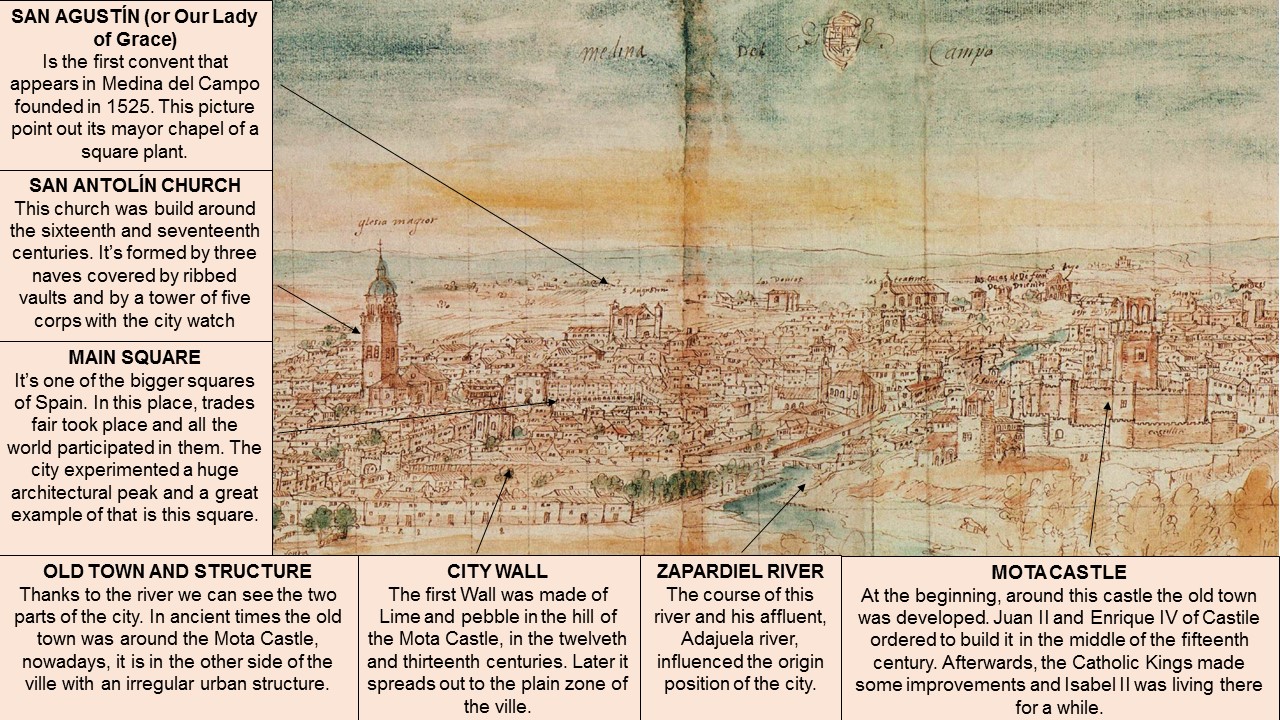MEDINA DEL CAMPO (Anton van den Wyngaerde, 1565)
This picture is a view of Medina del Campo, depicted by Anton Van Den Wyngaerde (Amberes, 1512/1525 – Madrid, 1571), and preserved in the Fundación Museo de las Ferias. Wyngaerde was a Belgian landscape draftsman who formed himself as a painter in Netherlands and dedicated all his life to transmit what he observed through the drawing or painting, creating a collection of 62 sights of landscapes. Moreover, he did not only draw landscapes, he also accompanied to the Spanish troop in the wars against Enrique II from France with the purpose of representing war scenes like San Quintín in 1557. From that time onwards, Wyngaerde serviced to Felipe II of Spain, and most of the places that he drew were ordered by this king. According to Pedro Miguel Ibáñez Martín (2003) Wyngaerde did not visit those landscapes the same dates that Felipe II. Regarding Medina del Campo, he travels twice to there, one of them was in 1565 and the other was in 1570.
This cultural period is the Renaissance and Wyngaerde was one of the first city painter in that time. The main characteristic of his art is the meticulous work and the topographic image description that, apart from displaying beauty, also serve as graphic documents to know several urbanistic, economic, social and cultural aspects. In 1986 it was published a book about Wyngaerde’s works called Golden Age Cities, by Richard L. Kagan, and from this book onwards a lot of articles have been written about their drawings. As an example, we can stand out The Medina del Campo Urban Structure by Antonio Sánchez del Barrio that had been one of the first and more serious references to this author.
Medina del Campo is a township which is situated in Valladolid province, in Castilla y León, and is where Zapardiel river go across. Moreover, is the connection of a big number of railway and road networks. The name “medina” comes from the Arabic, and means the old part of an Arabian City, althoug the origins of this city are Pre-Roman. It was an important and privileged site due to the support given by King Alfonso X in 1258. Afterwards, King Fernando IV convene as first time the Courts in Medina, celebrating several sessions during the 14th and 15th centuries. In 1421, the definitive ordinances for the settlement and trade activities were written. It is in the end of the Middle Age when when the city succeeded thanks to its trade fair, that achieved at the top of the economic activities in the Iberian Peninsula. Therefore, this city became into a commercial center for a lot of traders and merchants from athe whole Castilla.
Medina del Campo has been growing along the centuries. The old town played a defensive role and it was located where is now the Mota Castle, on the top of the hill. The urban layout in that epoch was irregular, with narrow and step streets, and around this old town churches and monasteries were built, preferently in high zones to be protected from the possible flooding of Zapardiel river. The second old town was settled in the plain area towards the northwest and, this time, with agricultural and ranching objectives, meaning with rural character. Little by little the urban network was forming. The third town is the current one, on the other side of Zapardiel river. In this case the purposes were commercial and thanks to it the city witnessed a huge urban expansion between the 14th and 15th centuries. In the south sector was created a town extension with residential buildings following a more regular plan, but over time that regularity going disappearing. Among the neighborhoods of Medina the most popular is Saint Thomas.
Medina del Campo has always had a city wall that over the time has been expanded. The first wall was built in the 12th century and its origin was Islamic. The original wall was around the Mota Castle, on top of the hill, though later it was spread out to the plain zone of Medina, in order to protect wider areas of the growing city.
After the Christian reconquest and its advance, new lands were available for pasture, due to this Spanish economy strongly empowered the cattle sector, and mainly the ovine breed. Medina del Campo grew as well thanks to it and a big cattle market is held twice a year, turning into one of the most important and known markets within Europe. This allowed the city to obtain some privileges, a but also noble people and kings visited Medina started to visit Medina on a regular bases. With regards to Agriculture its most important crops are cereal plants and vine. This city was very famous due to its trades fair, which were held for fifty days. The products exhibited there were wines, oils, condiments, pearls, and the most special product was wool. Overtime businessmen and finance profeesionals become more important than traders and merchants. In the second middle of sixteenth century economical crisis caused the fall of trade fairs.
A large artistic heritage exists nowadays, such as the Mota Castle (an Islamic castle built formed by four towers and an interior squared courtyard), San Antolin Church (is the major and main church in the city and it was Collegiate during 1480 and 1855), the church of Santa María la Real, San Miguel church (one of the most important temples in the city with a rectangular footprint and two naves) and San Juan de la Cruz chapel.
Beatriz Guzmán Serrano

